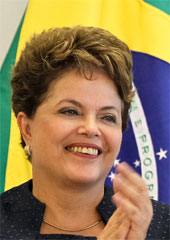Dilma Redux?
Brazil, like the United States, is now polarized politically, with two irreconcilable halves.
October 28, 2014

The re-election of President Dilma Rousseff as President of Brazil was not a foregone conclusion as little as a week ago. While the campaign could not have been dirtier, with charges of corruption, womanizing and wife-beating flying around, Rousseff’s Workers Party now seems set for another four years in office.
The PT is on the verge of having the longest running rule of one party in Brazil since the end of military rule in 1985.
Watching the Brazilian presidential campaign in Rio in its final days provided a useful window to talk to voters.
If this election reveals anything about the Brazilian electorate, it is that they are not yet ready to give up the socio-economic gains of the years under the PT’s stewardship of the country.
The 12 years of Labor government so far have created expectations for many millions of Brazilians to become part of the middle class. Even though the right-of-center candidate, former Minas Gerais governor Aecio Neves, promised to keep the social programs going, the majority of voters opted for the status quo.
The electorate was closely divided, though. With the final votes counted, Rousseff, with 51.6 % of the vote to Neves 48.5%, had only a 3%, or 3 million vote difference.
That foreshadows a polarization of what some have characterized as two irreconcilable halves – much as is the case now in the United States.
And indeed, if one looks at the map of Brazil, it is as if it has been cut in two: The northern states, which are poor and benefit greatly from the social welfare programs, wanted more of the same. Brazil’s southern half, where the states are far richer and more industrial, sought a new beginning.
They pinned their hopes on Governor Neves. His election platform was to open up trade and foreign direct investment, end the corruption of the Labor Party and project Brazil into a wider global market, while also retaining its leadership role in the global south.
A hidden gender gap?
In this traditionally high-testosterone nation, talk of a gender gap that favors women leaders is really not part of the political dialogue.
And yet, looking at the polls in the final week of the campaign, Dilma Rousseff gained the lead because of women seeing her as the better choice.
Women voters, especially from poorer areas, feel strongly about the Bolsa Familia, the cash-benefit social program which is credited with having lifted 40 million Brazilians out of poverty over the last decade.
This is no real surprise, given that women as heads of households are the primary beneficiaries of social programs, and are more in need of government support.
Women also see Dilma as a strong leader, someone who had fought against military rule in the 1970s. They often cited her courage when she was imprisoned and tortured by the military regime she rejected.
At the same time that Dilma was in jail, her opponent was leading the charmed life of a member of Brazil’s establishment.
Many voters I spoke with said that voting for Dilma was a vote for social inclusion, of giving better access to education in a nation that still has one of the largest income gaps in the world.
While the word “change” dominated the political discourse, Brazilian voters were really eager to have more of the same, for the sake of having social inclusion become a part of the Labor Party’s legacy.
Having a woman president in the fifth-largest country in the world is also a way to break down the traditionally machista culture that often dominates Brazil’s political debates.
Women are flexing their political muscle, showing that they want a voice in what some would describe as an election that marks a generational shift in Brazil.
Ending polarization
In her victory statement, Rousseff told her fellow Brazilians that there must be open political dialogue to end the deep divisions that became so apparent in this election.
But what will that dialogue look like? Will it bring together the business interests that Neves voters represented? Will it be forward looking in finding common ground for bringing the positions of both parties closer together in terms of greater trade and foreign direct investment?
Brazil’s government clearly needs reform. There are too many political parties. As a result, its Congress is highly fragmented, which makes it an obstacle to good governance.
No matter how the dialogue begins, it is essential for the different political factions to come together to create a new strategic vision for Brazil going forward.
Given the closeness of the election, it is important for the Labor Party’s legitimacy to make sure that it seizes the moment to bring opponents around the table quickly. Acting on this promise to convene will be the first test of Dilma’s ability.
The general thrust of her second term has to be about moving Brazil to a new reality as a consolidated democratic state that can manage both its winners and losers.
A divided electorate in a country the size of Brazil could be destabilizing at a time when the economy is hardly growing, even if unemployment is very low.
Implications for the United States
Brazil’s just concluded presidential election was about domestic politics, not about foreign policy. Yet, the need to rebuild a strong and positive relationship with the United States must become a priority for Rousseff in her second term.
With Dilma’s next term, starting in January 2015, she needs to move beyond the issue of National Security Agency cell phone intercepts to a wider conversation about what South America needs.
The entire region must become more effective in managing its internal needs for stability, economic growth and a common agenda toward trade.
But the devil is, as always, in the details – and the politics of symbolism matter greatly. Discussions of the upcoming 2015 Summit of the Americas in Panama will certainly put the United States and Brazil on a collision course regarding Cuba’s participation in that event.
That aside, it is high time for both countries to find common ground in the shared desire for ongoing economic growth and democratic governance in the Americas.
If all goes well, Rousseff’s second term in office may come to symbolize an important transition in the bilateral relationship – one that is based more in the 21st century than in the past.
Then, her victory would mark – as it well should – the end of a generation of leaders who still look to the United States with a certain inherent distrust as a legacy of times past.
Takeaways
Brazil is now polarized politically, with two halves – much as is the case now in the US.
While the word “change” dominated the election campaign, Brazilian voters were eager for more of the same.
Brazilian politics is fragmented. The country needs to come together to create a new strategic vision.

